Soil testing is a difficult process for farmers because of the cost, labor, and time associated with it. Collecting a sample of soil, sending it to a lab, and waiting for the results can be a lengthy and expensive process. Furthermore, the soil testing process can be unreliable due to environmental factors, such as the weather, that can affect the results.
Other methods, such as remote sensing, can also be deployed to help farmers more quickly and accurately determine soil health. Remote sensing involves using aerial imagery or satellites to measure the amount of nitrogen and other essential nutrients in the soil.
This method is more cost-effective and less time-consuming than traditional soil testing, and it can provide more accurate results. Additionally, remote sensing can help farmers better monitor soil health over time, allowing them to make more informed decisions about their farming practices.
However, all of these methods require the service of an expert, money, time, and other factors that new farmers may consider time-wasting, fund-consuming, and too sophisticated for small farm areas.
Cost-Effective Soil Testing: How To Conduct An Analysis At Home & Without Visiting Lab
The logic to getting your farmland soil test yourself is by simply observing the plants on the farmland before you deforest or clear the bush or weed on the soil. Nutrient deficiencies can manifest in a variety of ways in crops, and often manifest as physical signs.
These physical signs can be used to identify nutrient deficiencies and to diagnose the cause of plant health problems. We will be giving you eight physical signs of nutrient deficiencies in the soil and how to fix them shortly.
Before going to this, Why is the method the best and should be trusted?
- It saves you the time to take soil samples for laboratory tests.
- It saves you the money you will be needing to pay an expert to carry out the test for you or buy kits to do it yourself
- It gives you a good profile of your farmland soil nutrient chart. This is because a certain area of the farmland may lack Calcium but has another nutrient while the other may be lacking another. This will give you the ample privilege to plan your crops according to the soil profile of different areas of the farm. For instance, areas that needed more of one nutrient and less of others will be grouped and planted in areas you have mapped out based on plant nutrient present.
- Another reason is that soil testing by taking samples to a lab or remote sensing may not be suitable for new farmers or backyard farming.
Remember this method is best tested during the mild rain season, when rain is not much, and when the whole area is not in the dry season.
Video Demostration For Crops Nurient Deficiencies:
So, let us get to what you need to know while observing the farmland.
DIY Soil Testing: How to Conduct Tests at Home Without Spending a Dime or Visiting a Lab
Lookout for the following in the field, Leave color, plant growth, and fruit healthiness.
A. Nitrogen:
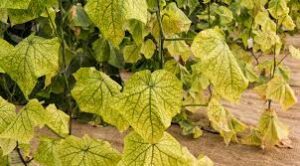
Nitrogen deficiency is one of the most common mineral deficiencies in crops, to know if your farmland soil is deficient in Nitrogen, the weed or bush on the farmland’s physical features will be characterized by yellowing of leaves, leaves, weak stems, and stunted growth.
Below is the Image to show plants or areas of the farmland that lack Nitrogen:

How to Fix Soil that Lacks Nitrogen With Organic Fertilizers:
- Compost:
Compost is a great source of nitrogen, and it can be made at home with kitchen scraps, grass clippings, and other organic materials.
- Blood Meal:
A blood meal is an animal by-product that’s high in nitrogen and can be added to the soil to help boost nitrogen levels.
- Fish Emulsion:
Fish emulsion is another great source of nitrogen that can be added to the soil to help plants that are lacking in nitrogen.
How to Fix Soil that Lacks Nitrogen With Inorganic Fertilizers:
- Ammonium Nitrate:
Ammonium nitrate is a synthetic fertilizer that provides a high concentration of nitrogen, making it a great choice for plants that are lacking in nitrogen.
- Urea:
Urea is another synthetic fertilizer that provides a high concentration of nitrogen. It’s often used in agricultural settings, but can be used in home gardens as well.
- Ammonium Sulfate:
Ammonium sulfate is a chemical fertilizer that provides a high concentration of nitrogen. It’s a good choice for plants that are lacking in nitrogen but should be used carefully as too much can burn plants.
B. Phosphorus:
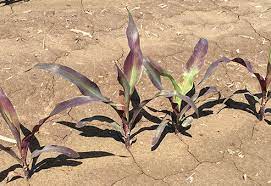
Phosphorus deficiency can cause the yellowing of leaves, stunted growth, and poor root development.
Plants that lack phosphorus typically have stunted growth, dark green leaves, and a purplish color on the older leaves. They may also have difficulty fruiting or flowering.
Below is the Image to show plants or areas of the farmland that lack Phosphorus:
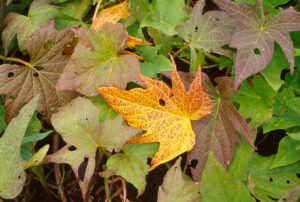
Three fertilizer products that can be added to the soil to provide phosphorus include:
Organic:
Bone meal, a ground-up powder made from steamed animal bones, is a good source of phosphorus for plants. Rock phosphate, a mined mineral that is ground into a fine powder, is another option for providing phosphorus to plants.
Inorganic:
Mono-Ammonium Phosphate (MAP) and Diammonium Phosphate (DAP) are two common inorganic fertilizers that can be used to provide phosphorus to plants.
Note: Organic fertilizers are derived from natural sources such as plants, animals, and minerals while inorganic fertilizers are synthesized in labs or factories.
C. Potassium:
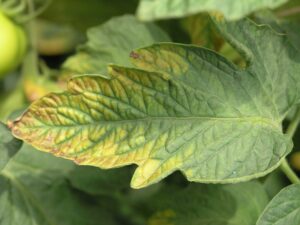
Potassium deficiency can cause the yellowing of leaves, decreased fruit production, and reduced plant vigor.
Plants that lack potassium may exhibit the following physical features:
Yellowing of older leaves
Slow growth
Smaller than normal fruit size
Reduced tolerance to cold temperatures
Below is the Image to show plants or areas of the farmland that lack Nitrogen:
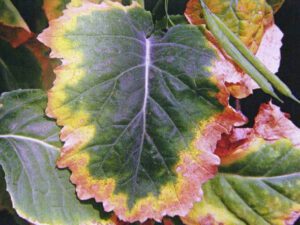
Organic fertilizers for adding potassium to the soil include:
Wood ash – a natural source of potassium that also provides other essential nutrients
Greensand – a mineral deposit that is mined and contains a high amount of potassium and other minerals.
Kelp meal – a powder made from seaweed that is a rich source of potassium and other micronutrients
Inorganic fertilizers for adding potassium to the soil include:
Potassium chloride (KCl) – a water-soluble fertilizer that can be easily absorbed by plants
Potassium sulfate (K2SO4) – a fertilizer that contains both potassium and sulfur, which are essential for plant growth
Potassium nitrate (KNO3) – a water-soluble fertilizer that provides both potassium and nitrogen, which are essential for plant growth.
D. Magnesium:
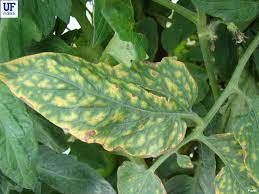
Magnesium deficiency can cause the yellowing of leaves, reduced flowering, and poor yields.
Plants that lack magnesium may exhibit several physical features, such as yellowing of the leaves (particularly between the veins), stunted growth, and reduced fruit or flower production. These symptoms are typically more pronounced in older leaves, as magnesium is an essential component of the chlorophyll molecule, which is responsible for photosynthesis.
Below is the Image to show plants or areas of the farmland that lack Nitrogen:
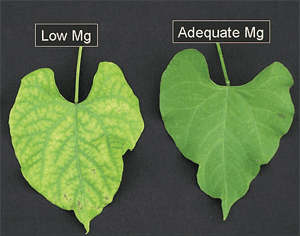
To add magnesium to the soil, several fertilizer products can be used, both organic and inorganic. Some examples include:
Epsom Salt (Magnesium Sulfate): An inorganic fertilizer that can be applied directly to the soil or added to a watering can for foliar feeding.
Dolomitic Lime: A natural source of magnesium and calcium that can be added to the soil to raise pH levels and provide essential nutrients.
Organic fertilizers such as bone meal or kelp meal are good sources of magnesium for plants.
Sulphate of Potash Magnesia(SOPM) is a fertilizer that contains magnesium, potassium, and sulfur. It can be used to correct nutrient deficiencies and improve the overall health of plants.
Magnesium Nitrate is a fertilizer that contains magnesium and nitrogen and can be used to correct nutrient deficiencies and improve the overall health of plants.
E. Calcium:
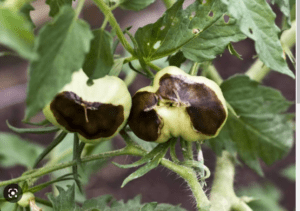
Calcium deficiency can cause the yellowing of leaves, stunted growth, and reduced root development.
Plants that lack calcium may exhibit a variety of physical symptoms, including:
Stunted growth
Weak stems that are easily broken or bent
Yellowing leaves, particularly on the lower part of the plant
Blossom end rot on fruits and vegetables
Poor root development
Below is the Image to show plants or areas of the farmland that lack Nitrogen:
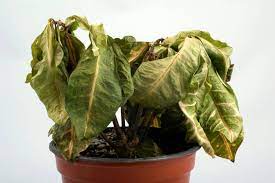
To add calcium to the soil, you can use a variety of fertilizer products, both organic and inorganic. Some options include:
Organic:
Bone meal: This is a byproduct of the meat industry and is made from ground, steamed bones. It’s an excellent source of calcium and other minerals.
Eggshells: These can be crushed and added to the soil as a source of calcium.
Inorganic:
Calcium nitrate: This is a water-soluble fertilizer that can be applied directly to the soil. It’s a good source of calcium and nitrogen.
Calcium chloride: This is also a water-soluble fertilizer and a source of calcium. It can be used to correct calcium deficiencies in the soil.
Gypsum: It is a natural mineral that contains calcium and sulfur. it can be used to correct soil compaction and improve the structure of the soil.
Please note that not all fertilizers will work for all plants, therefore it’s important to check the soil pH, and consult with a local expert or extension office for specific recommendations for your area.
F. Iron:
Iron deficiency can cause the yellowing of leaves, reduced growth, and decreased yields.
Plants that lack iron may exhibit a variety of physical symptoms, including:
Chlorosis or yellowing of leaves, particularly between the veins (interveinal chlorosis)
Pale or yellowish-green leaves
Stunted growth
Slow maturity
Reduced yield
Below is the Image to show plants or area of the farmland that lack Nitrogen:
To add iron to the soil, you can use a variety of fertilizer products, both organic and inorganic. Some options include:
Organic:
Blood meal: This is a byproduct of the meat industry and is made from ground, dried blood. It’s an excellent source of iron and nitrogen.
Compost: Compost is a natural soil amendment that can help to improve the overall health and fertility of the soil, including increasing iron availability.
Inorganic:
Iron sulfate: This is a water-soluble fertilizer that can be applied directly to the soil. It’s a good source of iron and sulfur.
Iron chelate: This is a water-soluble fertilizer that can be applied directly to the soil. It is a form of iron that is more readily available to plants.
Ferrous Sulfate: It is a common iron supplement for plants that can be used to correct iron deficiency in the soil.
Please note that not all fertilizers will work for all plants, therefore it’s important to check the soil pH, and consult with a local expert or extension office for specific recommendations for your area. Also, It’s important to note that adding too much iron to the soil can cause other nutrient imbalances and lead to other issues, therefore it’s important to follow the manufacturer’s instructions when applying any fertilizer.
G. Sulfur:
Sulfur deficiency can cause the yellowing of leaves, reduced growth, and decreased yields.
Plants that lack sulfur may have yellowed leaves, stunted growth, and poor seed production. These symptoms occur because sulfur is an essential nutrient for plants, and is involved in many of the plant’s metabolic processes, including protein synthesis and chlorophyll production.
Below is the Image to show plants or areas of the farmland that lack Nitrogen:
Some of the best fertilizer products to add to the soil for plants that lack sulfur include:
Epsom salt- Epsom salt is a natural source of sulfur and can be added to the soil as a fertilizer. It can be applied at a rate of 1-2 tablespoons per gallon of water and can be applied to the soil or as a foliar spray.
Ammonium sulfate- Ammonium sulfate is a common inorganic fertilizer that contains high levels of sulfur. It can be applied at a rate of 1-2 pounds per 100 square feet and should be incorporated into the soil prior to planting.
Elemental Sulfur- Elemental sulfur is a natural and organic form of sulfur. It can be added to the soil by using it in the form of granules or powder. It is applied at the rate of 1-2 pounds per 100 square feet and incorporated into the soil.
Gypsum- Gypsum is a natural mineral that contains calcium and sulfur. It can be applied at a rate of 20-40 pounds per 1,000 square feet and should be incorporated into the soil prior to planting.
Compost- Compost is a good source of many essential nutrients, including sulfur. It can be applied at a rate of 1-2 inches and incorporated into the soil.
It is important to note that it is always good practice to consult with a soil test before adding any kind of fertilizers to the soil
H. Manganese:
Manganese deficiency can cause the yellowing of leaves, reduced growth, and decreased yields.
I. Copper:
Copper deficiency can cause the yellowing of leaves, reduced growth, and decreased yields.
J. Zinc:
Zinc deficiency can cause the yellowing of leaves, reduced growth, and decreased yields.
Some Common Diseases You May Observe on Farmland
1. Chlorosis:
Chlorosis is the yellowing of leaves due to a lack of chlorophyll. It is a common symptom of iron, zinc, and manganese deficiencies.
2. Necrosis:
Necrosis is the death of plant tissue due to a lack of nutrients. It can be caused by a lack of nitrogen, phosphorus, potassium, or other essential nutrients.
3. Leaf Roll:
Leaf roll is a symptom of calcium deficiency, where the leaves curl up and become brittle.
4. Leaf Margin Burn:
Leaf margin burn is a symptom of magnesium deficiency, where the edges of the leaves turn brown and die back.
5. Leaf Scorch:
Leaf scorch is a symptom of sulfur deficiency, where the leaves turn yellow and dry up.
6. Stunted Growth:
Stunted growth is a symptom of a lack of essential nutrients, such as nitrogen, phosphorus, and potassium.
7. Fruit Drop:
Fruit drop is a symptom of boron deficiency, where the fruits fail to develop and drop off the plant prematurely.
8. Blossom End Rot:
Blossom end rot is a symptom of calcium deficiency, where the fruits develop brown or black lesions at the blossom end.
Most time farmers may want to undergo the practice of testing their farmland soils before planting any crops or carrying out any activities on the farmland. Usually, the best guide to do this is to take some of the soil samples and take them to the lab for tests or get test kits and do it yourself. You can read how to take soil samples and do a laboratory test here at this link.
Nonetheless, this may be too demanding and sometimes may take much time if you are to send it to the laboratory. So, by observing your farmland carefully, you can determine the nutrients the soil is lacking and how to fix it practically.
Conclusion
Minerals are essential for the growth and development of plants, providing the nutrients required for basic metabolic processes, structural components of cells, and essential vitamins and hormones.
However, when mineral deficiencies occur in crops, plants may suffer from stunted growth and reduced yields, making them vulnerable to pests and diseases. Here is a list of 10 minerals that commonly cause deficiencies in crops and the symptoms associated with each:
To prevent mineral deficiencies in crops, farmers should ensure that their soil contains adequate amounts of essential minerals, and should be tested regularly to ensure mineral levels remain optimal.
Additionally, providing regular fertilizer applications can help boost mineral levels in the soil. Finally, selecting crop varieties that are resistant to mineral deficiencies can be beneficial, as some varieties are more tolerant to mineral deficiencies than others. By taking these steps, farmers can ensure their crops remain healthy and productive.
By recognizing these physical signs of nutrient deficiencies in crops, farmers and gardeners can diagnose and treat nutrient deficiencies quickly, resulting in healthier and more productive crops.


![How To Start Organic Farming In UAE [Beginner’s Guide]](https://agrolearner.com/wp-content/uploads/2023/12/Organic-Farming-780x520.jpg)
